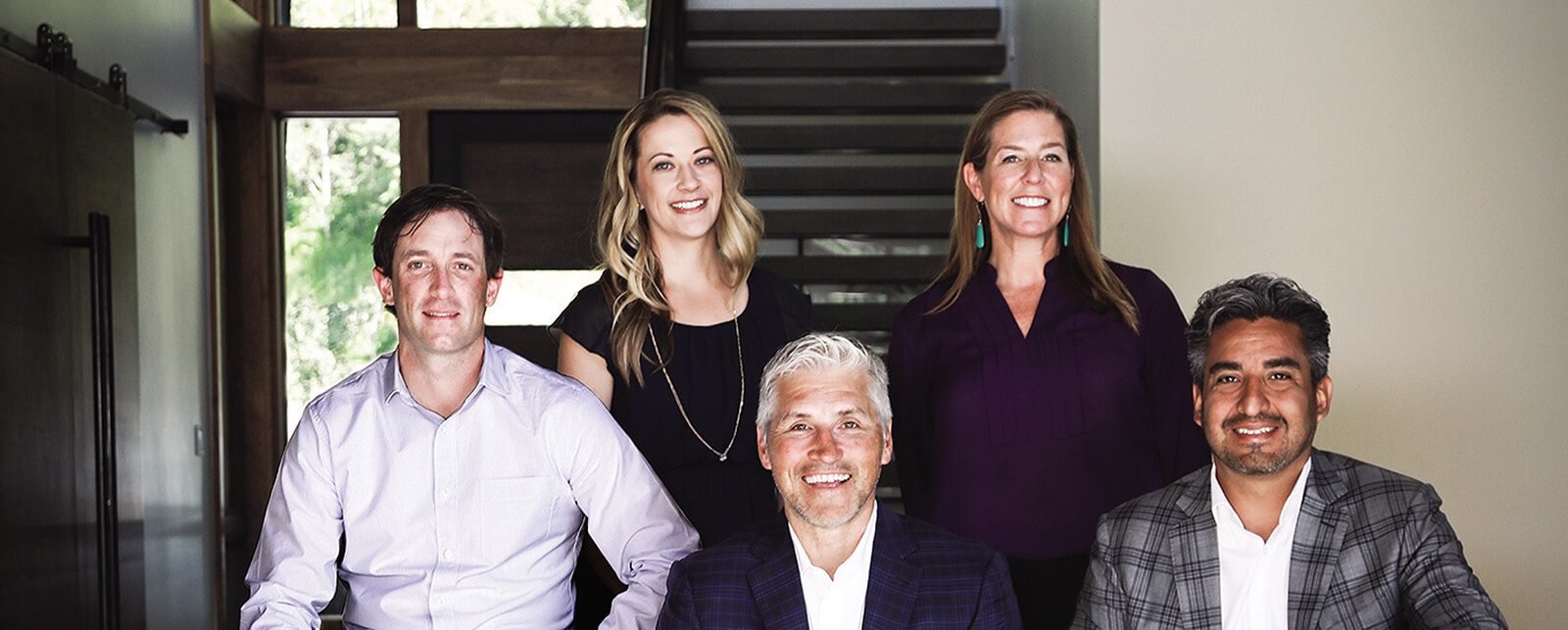Climbing up Eagle County’s classic fourteener is the easy part when you’re planning on skiing down the peak’s harrowing Cross Couloir.
Aside from being the Vail Valley’s most-climbed pinnacle, Mount of the Holy Cross happens to be one of America’s most famous peaks—and has been since William Henry Jackson’s iconic photograph of the east face was published in National Geographic in 1873. Jackson’s shot depicted a majestic cross of snow in the middle of an otherwise sheer rock wall, deep in the Colorado wilderness, and so captivated Americans that the peak became a religious shrine, attracting thousands of Christian pilgrims each season to an overlook at Notch Mountain where, in the mid-1920s, a stone shelter was erected to accommodate the crowds. By 1929, so many were visiting the mount that Herbert Hoover declared it a National Monument, ultimately maintained by the National Park Service.
But the love affair was short-lived: after erosion and rock slides obliterated much of the snow-filled crease forming the icon’s horizontal arm on climber’s right, Holy Cross’s prominence as a shrine waned. Visitation plummeted, and in 1950 Congress stripped the peak of its National Monument status and cast it off to the U.S. Forest Service. Nevertheless, as Eagle County’s sole fourteener, Holy Cross retains its allure as a mecca for summertime endurance hikers, myself included.
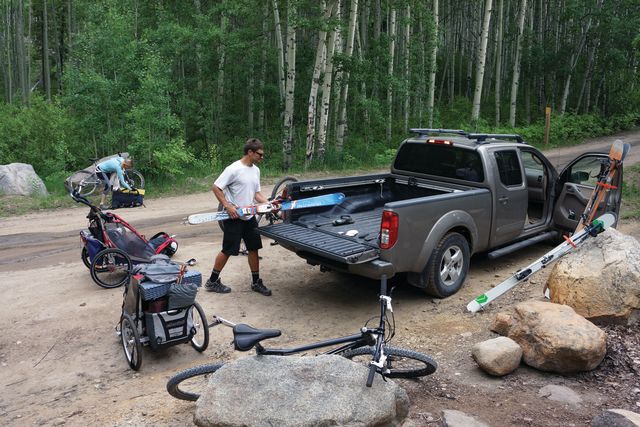
Loading bike trailers at the base of Tigiwon Road
IMAGE: BRENNAN LAGASSE
I first summited Holy Cross with a pair of college friends in the summer of 2003. Simply completing the 10-mile, 5,600-
vertical-foot hike pushed me to my physical and emotional limits; having run out of water, we staggered back to the car like zombies before collapsing in the grass. I climbed the mount twice more in subsequent years, each time peering down from the pinnacle into the Cross Couloir, the snow chute that forms the vertical component of the peak’s compromised cross, imagining myself someday skiing it.
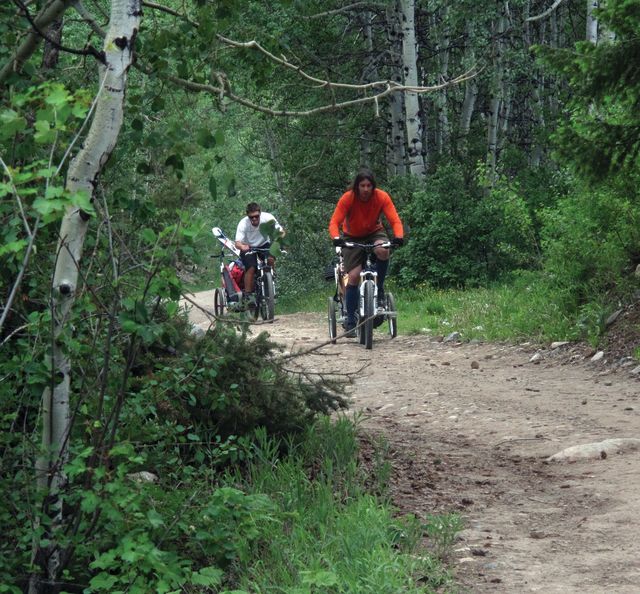
Hauling 80-pound loads
IMAGE: BRENNAN LAGASSE
If it were as easy as just descending the 1,100-foot tube off of the summit, you can bet scores more people would drop in. The terrain is imposing but not out of reach for skilled and committed skiers. (In July 2005, for instance, Vail adventure racer Mike Kloser led his son and daughter down the couloir when they were 11 and 12 years old, respectively.) The couloir chokes down to roughly 20 feet at its narrowest point and generally falls away at a 38- to 40-degree angle—hardly precipitous in the world of extreme ski descents, though steep enough that you wouldn’t want to fall and consequential enough, thanks to an exposed lower section, to incite fear in me whenever I contemplated the prospect.
But there are two elements that set the Cross Couloir apart from virtually every other line like it in Colorado. First: the approach. The only way to reach the couloir, assuming you intend to climb what you ski (which I did), is by hiking up and route-finding over many miles of uneven, rocky, maddening terrain with no established trail. Second: the peril. Because the couloir ends in a 60-foot cliff most seasons, there is little margin for error while ascending or descending the route, and even a small avalanche could sweep you to your death.
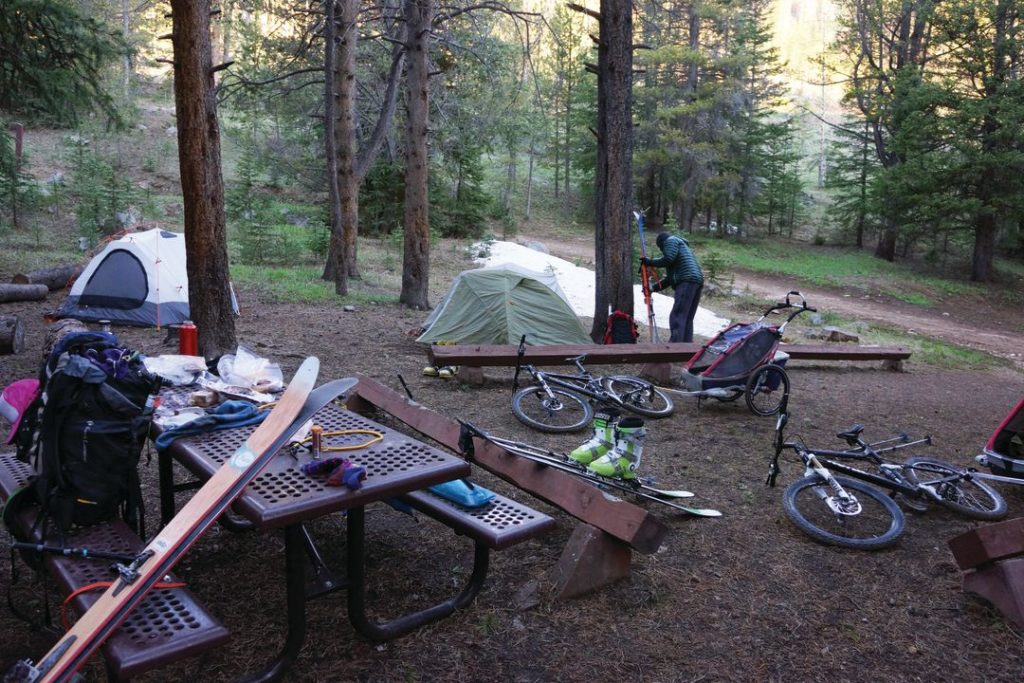
2,200 vertical feet and three hours later, unloading at Half Moon base camp
IMAGE: BRENNAN LAGASSE
Still, as conscious and cautious of these hazards as I was, the couloir offered something else that inevitably drew me toward it: the prospect of an adventure with an uncertain outcome. So one afternoon last May, when I received an e-mail from Brennan Lagasse, an adventure buddy and ski guide from Lake Tahoe, asking if I might be interested in skiing the Cross Couloir with him that June, it took me only a few seconds to respond: “Yes.”
If you wait until the summer solstice to attempt Holy Cross, you can drive nine miles on the seasonal Tigiwon dirt road from Highway 24 to the Half Moon Campground, where most attempts begin. If you can’t wait, hitching a trailer to a mountain bike is as good an option as you’ll find. We decided to ride in on the 18th, three days before the road opened and the masses descended (and ascended), and set out to ski the couloir the next morning.
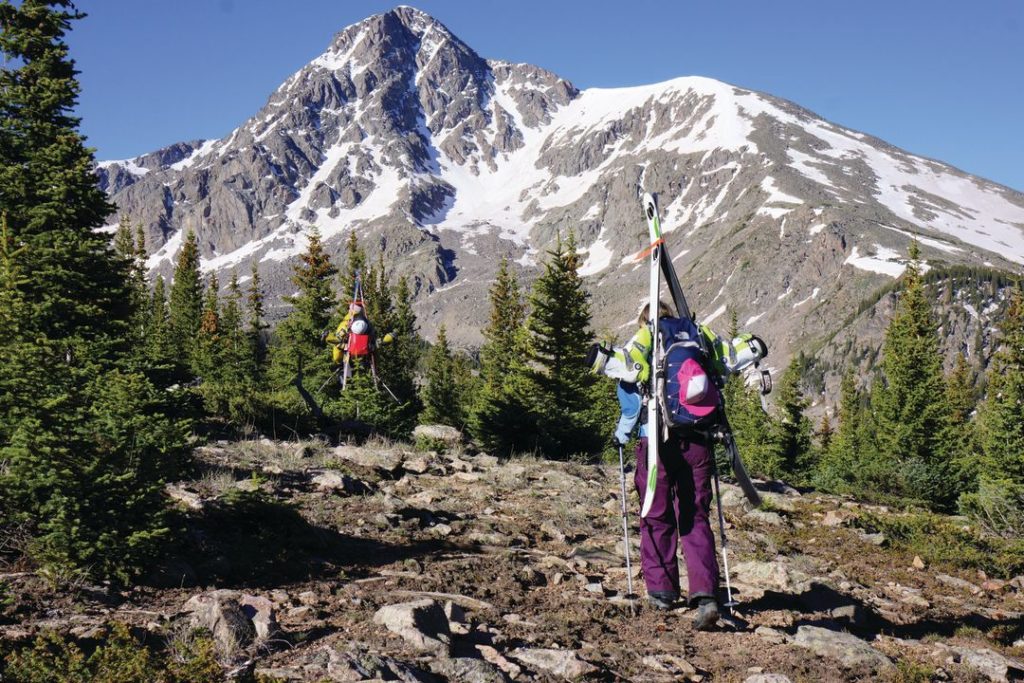
Just after dawn, the hike to the epic descent begins.
Our journey did not begin well. We were loaded down with 80 pounds of gear apiece (including tents, sleeping bags, food, skis, poles, boots, crampons, ice axes, helmets, beer, and the requisite layers of waterproof and thermal apparel), and when Brennan tried to pedal up the first hill, he ended up walking back to our truck parked at the gate shaking his head. “I don’t know if this is going to work,” he said. It was 6 p.m. on a Wednesday, and the mosquitoes were swarming in clouds.
We moved some weight around and finally began the 2,200-foot climb up Tigiwon to Half Moon, swatting mosquitoes as we inched uphill in our granny gears. Morale was low already. When Brennan’s trailer came unhinged 200 yards into the climb, he dropped the bike and took off running, arms flailing, bugs winning.
It took nearly three hours to reach the campground. We rolled in just after dark, utterly pooped. Six hours of sleep that seemed more like six seconds later, we awoke.
I had an uneasy feeling in my gut. I knew it was going to warm up fast, and we had a long way to go before even reaching the snow in the couloir. Neither of us had done this route before. I’d heard it was tough and scrambly in places, hardly an encouraging description. Nevertheless, just after dawn we left our bikes at a campsite, shouldered packs containing all of our gear and provisions, and set out in silence up the trail.
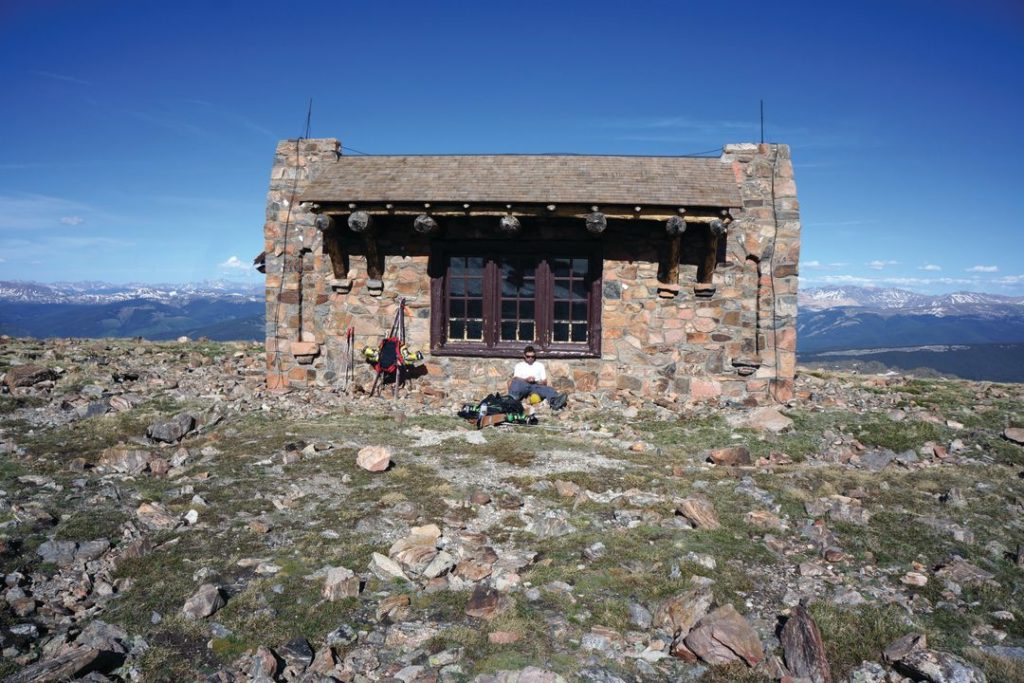
A well-earned rest at the Notch Mountain stone shelter, a relic from 1920s-era pilgrimages
IMAGE: BRENNAN LAGASSE
Soon after cresting Half Moon Pass and beginning the descent toward East Cross Creek, we got our first glimpse of the terrain that would take us up to the couloir. It looked even more rugged than anticipated. We proceeded up the drainage toward a melting (yet still largely frozen) waterfall, the first in a series of obstacles that would slow our progress.
Trading hiking boots for ski boots, we spidered up to a ledge. I grabbed the wet rock with my right hand just as my right boot lost purchase and slipped into the void, leaving me dangling next to the cascade. Brennan was too far ahead to hear my shouts over the rushing water. I used my arms to pull myself up and get my feet under me, then continued the climb. My heart was still pounding when I reached the top a few minutes later.
Using ski poles to whack our way through dense willows that seemed to claw at our ankles and legs in an effort to pull us backward—the mother of all mental obstacles—we moved up the mountainside gradually, around the edge of Lake Patricia (a shallow pool of snowmelt between Notch and Holy Cross), across talus slopes, and over a field of boulders, postholing through a tenuous snowpack that regularly collapsed under our weight, leaving us wallowing up to our crotches.
Both companies screen clients due to the huge physical effort Holy Cross requires, but if you’re deemed capable, you’ll join local experts for an alpine start (typically leaving the trailhead by 6 a.m.) and should expect to be moving for eight to twelve hours. Paragon’s trips include lunch and snacks as well as hiking poles ( paragonguides.com, 970-926-5299). Beaver Creek also provides gear to clients, including Salomon boots and packs, rain jackets, and Leki trekking poles, as well as Nature Valley bars and Gatorade. Trips run from mid-June to the end of October (beavercreek.com, 970-754-5373).
As the sun beat down on us mercilessly, my misgivings grew. I could tell Brennan was questioning the outcome as well, but it made no sense to talk about it until we reached the snow. Around noon, after what seemed like an eternity, we arrived, 1,100 feet below the summit, gazing up into a chute full of runnels and miniature penitents—stalagmites of snow shaped by the hot spring sun. Our white whale. It wasn’t exactly grade A corn, but it was certainly skiable, and the snow provided ample purchase in crampons, with a firm base under a soft five inches.
Kick, step, kick, step. We started our climb, literally ascending a foot at a time. Forty-five minutes later, at 1:30 p.m., we were standing on the summit, at the lip of the couloir. No one else was in sight. We donned helmets and goggles, clicked into our skis, and surveyed a stunning and bleached landscape around us—the Rocky Mountains in full effect. Conscious of a jangle of nerves and excitement as I slid toward the entrance, I peered cautiously into newly familiar terrain that still felt palpably like a great unknown.
Then I dropped.
And I carved the first of many exhilarating wide turns in white snow on the sheltered skier’s right side of the couloir. The arc sent a rush coursing through me; after all the years of picturing this moment, I was finally here, charging down the cross. I found a rhythm and continued to the most walled-in section of the line, which felt like skiing through a cavernous hallway. I stopped to snap a few photos of Brennan as he ripped past, grinning and focused. It was over in minutes.
The day before, I had taken great care to create a sandwich worthy of our highly anticipated post-ski adrenaline-rush comedown: turkey, avocado, aged cheddar, and expensive mustard on seeded sourdough, sealed in a plastic bag. I had stashed my sandwich, as well as a few other items we wouldn’t need for the climb, on a rock at the bottom of the couloir before we began kicking steps. I can only imagine how pleased the hungry little pika must have been to discover that sandwich sitting on that rock, with the closest humans halfway up the couloir.
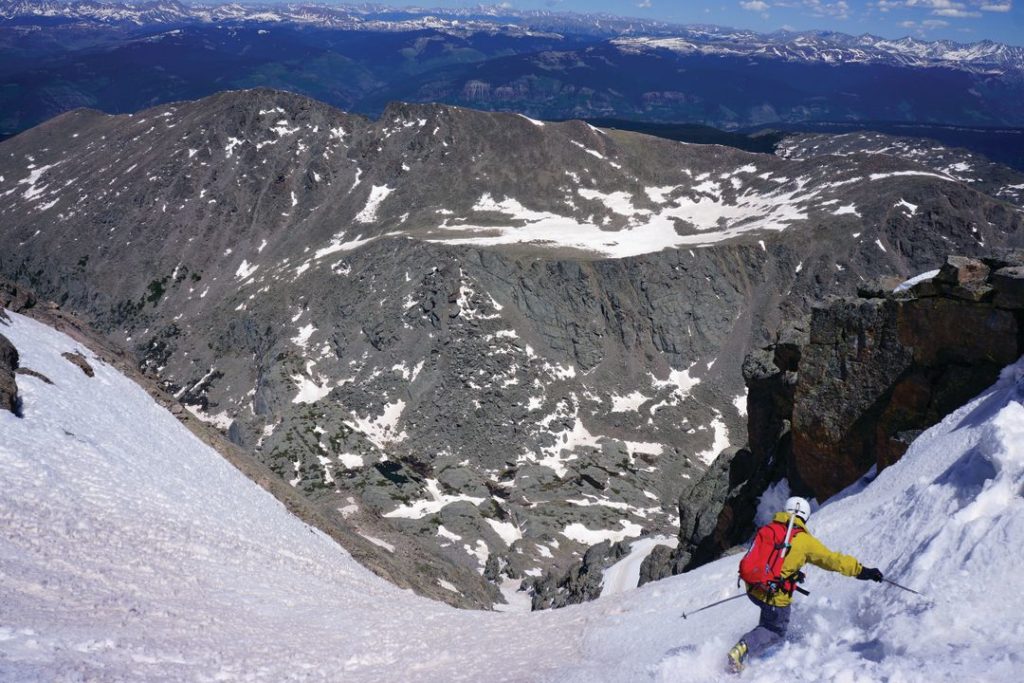
Carving the first exhilarating turns
IMAGE: BRENNAN LAGASSE
Neither Brennan nor I wanted to descend the melting waterfall, so we scrambled up a different ridge on the west side of Notch Mountain, toward the stone shelter that sits just below the summit at 13,077 feet, where all those pilgrims once gathered to gaze up at the cross. By the time we reached the shelter, majestically perched on a grassy plateau dotted with yellow wildflowers, it was 6:30 p.m. and the sun was setting on the summit, bathing it in heavenly yellow light. We stared across the valley at the shaded couloir we had just skied, detached from the world of humans, transfixed by the white cross inscribed on a dark mountain.
It had been a taxing day: 14 hours traveling through rugged and unforgiving country. But the special feeling of satisfaction you take with you after an adventure like skiing the Cross Couloir—the simple feat of turning the unknown into the known—is enough to numb the suffering for as long as the memory lives.
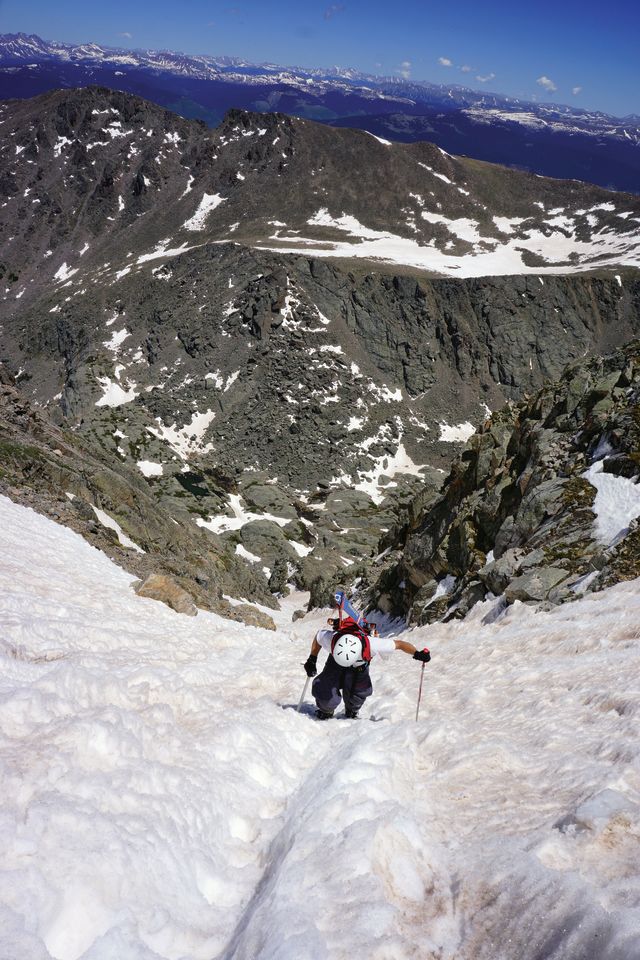
Kicking steps up the Cross Couloir
Pilgrim’s Progress; Never mind skiing the Cross Couloir; simply hiking Holy Cross via the standard north ridge route is a significant challenge. If you don’t feel like tackling it on your own, hire one of the outfitters that offer guided hikes of the peak, Paragon Guides and Beaver Creek Hiking Center. If you’re not quite ready for the whole enchilada, consider a trip with Walking Mountains Science Center, an outfitter that guides all-day hikes to Notch Mountain, Cross Creek, and a handful of other sites around Holy Cross. You’ll learn about geology, water scarcity, and homesteading history while ogling the highest peak in Eagle County (walkingmountains.org, 970-827-9725). Finally, those who want to witness the majestic vista captured by William Henry Jackson’s iconic photo in the manner of a 20th-century pilgrim (forgoing the summit), should consider joining Scott Beebe’s annual public trek to the Notch Mountain summit overlook on July 11. Beebe, pastor of Mount of the Holy Cross Lutheran Church and a member of Vail Mountain Rescue Group, promises a safe and spiritual (but not necessarily religious) adventure for all comers. Hike leaves from the Half Moon trailhead at 7 a.m. sharp (register at mountholy.com).
